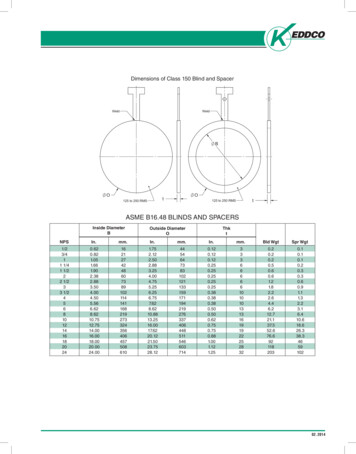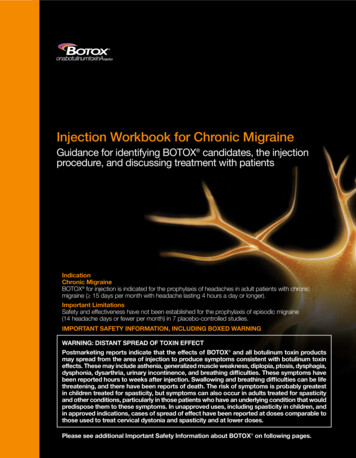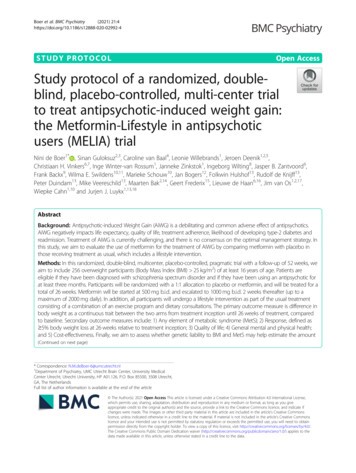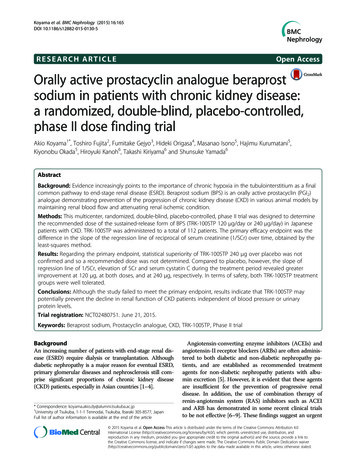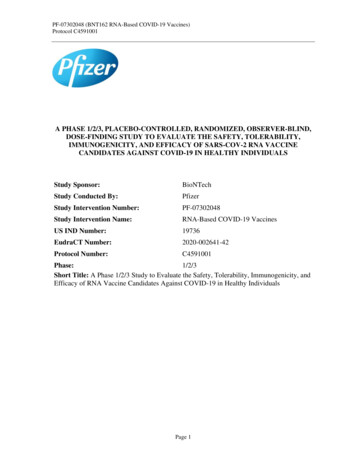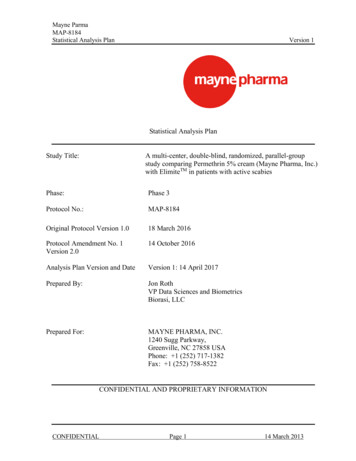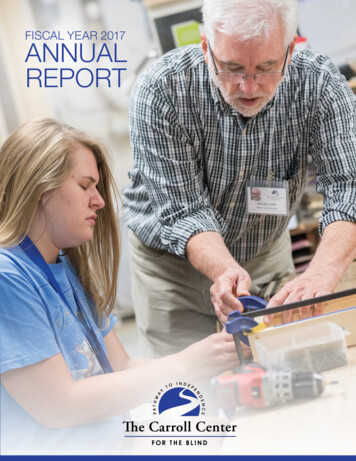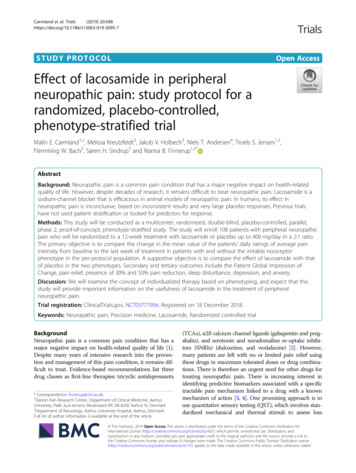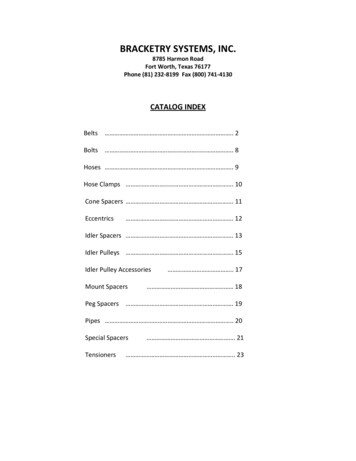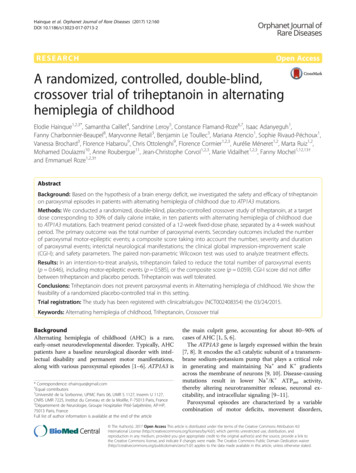
Transcription
Hainque et al. Orphanet Journal of Rare Diseases (2017) 12:160DOI 10.1186/s13023-017-0713-2RESEARCHOpen AccessA randomized, controlled, double-blind,crossover trial of triheptanoin in alternatinghemiplegia of childhoodElodie Hainque1,2,3*, Samantha Caillet4, Sandrine Leroy5, Constance Flamand-Roze6,7, Isaac Adanyeguh1,Fanny Charbonnier-Beaupel8, Maryvonne Retail3, Benjamin Le Toullec3, Mariana Atencio1, Sophie Rivaud-Péchoux1,Vanessa Brochard3, Florence Habarou9, Chris Ottolenghi9, Florence Cormier1,2,3, Aurélie Méneret1,2, Marta Ruiz1,2,Mohamed Doulazmi10, Anne Roubergue11, Jean-Christophe Corvol1,2,3, Marie Vidailhet1,2,3, Fanny Mochel1,12,13†and Emmanuel Roze1,2,3†AbstractBackground: Based on the hypothesis of a brain energy deficit, we investigated the safety and efficacy of triheptanoinon paroxysmal episodes in patients with alternating hemiplegia of childhood due to ATP1A3 mutations.Methods: We conducted a randomized, double-blind, placebo-controlled crossover study of triheptanoin, at a targetdose corresponding to 30% of daily calorie intake, in ten patients with alternating hemiplegia of childhood dueto ATP1A3 mutations. Each treatment period consisted of a 12-week fixed-dose phase, separated by a 4-week washoutperiod. The primary outcome was the total number of paroxysmal events. Secondary outcomes included the numberof paroxysmal motor-epileptic events; a composite score taking into account the number, severity and durationof paroxysmal events; interictal neurological manifestations; the clinical global impression-improvement scale(CGI-I); and safety parameters. The paired non-parametric Wilcoxon test was used to analyze treatment effects.Results: In an intention-to-treat analysis, triheptanoin failed to reduce the total number of paroxysmal events(p 0.646), including motor-epileptic events (p 0.585), or the composite score (p 0.059). CGI-I score did not differbetween triheptanoin and placebo periods. Triheptanoin was well tolerated.Conclusions: Triheptanoin does not prevent paroxysmal events in Alternating hemiplegia of childhood. We show thefeasibility of a randomized placebo-controlled trial in this setting.Trial registration: The study has been registered with clinicaltrials.gov (NCT002408354) the 03/24/2015.Keywords: Alternating hemiplegia of childhood, Triheptanoin, Crossover trialBackgroundAlternating hemiplegia of childhood (AHC) is a rare,early-onset neurodevelopmental disorder. Typically, AHCpatients have a baseline neurological disorder with intellectual disability and permanent motor manifestations,along with various paroxysmal episodes [1–6]. ATP1A3 is* Correspondence: ehainque@gmail.com†Equal contributors1Université de la Sorbonne, UPMC Paris 06, UMR S 1127, Inserm U 1127,CNRS UMR 7225, Institut du Cerveau et de la Moëlle, F-75013 Paris, France2Département de Neurologie, Groupe Hospitalier Pitié-Salpêtrière, AP-HP,75013 Paris, FranceFull list of author information is available at the end of the articlethe main culprit gene, accounting for about 80–90% ofcases of AHC [1, 5, 6].The ATP1A3 gene is largely expressed within the brain[7, 8]. It encodes the α3 catalytic subunit of a transmembrane sodium-potassium pump that plays a critical rolein generating and maintaining Na and K gradientsacross the membrane of neurons [9, 10]. Disease-causingmutations result in lower Na /K ATPase activity,thereby altering neurotransmitter release, neuronal excitability, and intracellular signaling [9–11].Paroxysmal episodes are characterized by a variablecombination of motor deficits, movement disorders, The Author(s). 2017 Open Access This article is distributed under the terms of the Creative Commons Attribution 4.0International License (http://creativecommons.org/licenses/by/4.0/), which permits unrestricted use, distribution, andreproduction in any medium, provided you give appropriate credit to the original author(s) and the source, provide a link tothe Creative Commons license, and indicate if changes were made. The Creative Commons Public Domain Dedication o/1.0/) applies to the data made available in this article, unless otherwise stated.
Hainque et al. Orphanet Journal of Rare Diseases (2017) 12:160oculomotor abnormalities, pain, autonomic disorders,and seizures [2–4]. Their frequency, severity and duration are highly variable, both in a given patient andfrom one patient to another. They are often triggered byintense emotions, sensory stimuli such as temperatureand light changes, fasting, and physical problems such asinfections and trauma [2–4, 12]. Paroxysmal manifestations markedly undermine these patients’ quality of life,and their treatment is highly problematic [13]. Themechanism linking Na /K ATPase to paroxysmal eventsin AHC is largely unknown. Both clinical and radiological data have raised the possibility that a transientbrain energy deficit might play a critical role for the paroxysmal manifestations of AHC. Clinical observationfound similar triggering factors in AHC and in obviousdisorders of brain energy metabolism such as GLUT1deficiency syndrome [12, 14, 15]. Imaging studies described cerebral glucose hypometabolism on interictalperiod in human [16] and in a AHC mouse model(Myshkin mice) [17]. Furthermore, ketogenic diet, whichefficiently compensates for defective cerebral glucosemetabolism, has shown some efficacy on AHC paroxysmal episodes [14, 15, 18].Triheptanoin (UX007; Ultragenyx PharmaceuticalsInc.; Novato; USA) is a medium odd-chain triglyceridecontaining three 7-carbon fatty acids. Its metabolismyields appropriate substrates for both fatty acid metabolism and anaplerosis. Triheptanoin is well tolerated andhas been shown to improve clinical manifestations and/or brain metabolism in various disorders associated withpatent brain energy deficits, such as glucose transporterdeficiency [19], pyruvate carboxylase deficiency [20], andHuntington’s disease [21].The aim of this randomized, double-blind, placebocontrolled crossover study was to assess the safety andefficacy of triheptanoin on paroxysmal episodes in patients with alternating hemiplegia of childhood due toATP1A3 mutations.MethodsStudy design and interventionThis was a randomized, double-blind, placebo-controlledcrossover study. All study visits took place at the ClinicalInvestigation Center for Neurosciences at the Brain andSpine Institute of Pitié-Salpêtrière Hospital betweenMarch 2015 and May 2016. The crossover study comprised two treatment periods, one with triheptanoin andthe other with placebo (safflower oil with an indistinguishable taste and identical packaging), separated by a4-week washout period (Fig. 1).Each treatment period consisted of a 12 ( 2)-weekfixed-dose phase, except that only half the daily dosewas given on the first day. A trained dietician determined the daily calorie intake for each patient andPage 2 of 7Randomizedn 10Triheptanoin (n 5)Visit 1W0Placebo (n 5)12 weeks12 weeksWashout (n 10)4 weeksPlacebo (n 5)Triheptanoin (n 5)12 weeks12 weeksCompletedn 10Visit 2W12Visit 3W16Visit 4W28Analyzedn 10Fig. 1 Flow chart of trial participantsadjusted his or her daily menu to ensure both propertreatment administration and an isocaloric diet. The patients were asked to ingest a treatment dose (triheptanoin or placebo) representing around 30% of their usualdaily calorie intake. The target dose corresponding to30% of daily calorie intake was defined by metabolismanalysis in rodent study [22, 23] and previous clinical trials in human [19, 24]. Treatment was administered during meals, three to four times a day. Treatment wasdiscontinued abruptly for the 4-week washout period,during which the patients resumed their habitual diet.We chose this long washout period to allow rest for thepatients between visits 2 and 3. Dietary and therapeuticadherence was assessed by the dietician at visits 2 and 4.Outcome measuresDemographic data were collected at the beginning of thestudy, along with information on the ATP1A3 mutation.Clinical and biological assessments were done at each visit.Neurological paroxysmal events related to AHC wereassessed during each study phase, based on a comprehensive daily diary kept by the patient and/or primary caregiver. All paroxysmal events were recorded, whether motor(palsy, stiffness, oculomotor or limb movement disorders,dysarthria) seizure or non-motor (headache, fatigue, moodswings), along with their severity (scored 0–3) and theirapproximate duration in minutes, as previously described[19]. If a patient had a combination of two motor manifestations within one event, it was counted as one event. Aremission period of 15 min during full wakefulness wasarbitrarily used to define two different events. A non-motormanifestation was therefore considered as part of a singleevent if it started within 15mn after the end of the motorevent or if it ended within 15 mn before the motor event.At each visit, the evaluating physician reviewed all paroxysmal events. Clinical changes were assessed with the ClinicalGlobal Impression-Improvement Scale (CGI-I, range 0–7),completed both by the physician and by the patient.
Hainque et al. Orphanet Journal of Rare Diseases (2017) 12:160Safety was assessed at each visit by means of an adverse events (AE) questionnaire, as well as bodyweightmeasurement and laboratory tests (serum electrolytes,blood cell counts, hepatic and renal function tests,plasma C5-keto acids [19]). Hypnosis was offered to support smooth running of blood sampling procedures.Blood was collected in the morning, after an overnightfast (visits 1 and 3), or 90 min after the last intake of thestudy medication (visits 2 and 4).The primary endpoint was the total number of paroxysmal events during the triheptanoin and placebo periods. Secondary outcomes were the number of motorepileptic paroxysmal events, a composite score takinginto account both the number of episodes and their severity and duration (cf. equation), interictal neurologicalmanifestations, and the CGI-I.Composite score ¼Pn i¼0 Severity Durationof the most severe symptomNumber of weeksBiochemical analysesHere, “C5 keto acids” refers to the two species of 5carbon-unit monocarboxylic acids carrying either 3-ketoor 3-hydroxy radicals. Their plasma levels were measured by organic extraction, trimethylsilylation (BSTFA 1% TMCS, Sigma) and gas chromatography-massspectrometry in SIM mode (Scion TQ mass analyzer,Brüker). Quantification was calibrated on known amountsof unlabeled analytes relative to stable-isotope-labeledinternal standards (3,4,5-13C3 3-ketopentanoate fromEurisotop, Saint Aubin, France and 2,2,3,3,4,4,5,5,6,6-d106-hydroxyhexanoic acid from Sigma-Aldrich). The concentrations of plasma C3-carnitine, produced only by triheptanoin due to its odd number of carbons, were alsomeasured as described [20].Page 3 of 7the two treatment sequences, namely triheptanoinfollowed by placebo, and placebo followed by triheptanoin. For each patient, an inclusion number was provided to the investigators upon connection to therandomization platform. Each inclusion number corresponded to an individual sequence and the patientremained in it throughout the study. Only the pharmacists were aware of the sequence, and dispensed triheptanoin or placebo accordingly. The pharmacists werealso responsible for the unblinding process if requiredby the safety committee. All patients, caregivers and investigators were blinded to the treatment allocation. Triheptanoin and placebo were supplied by UltragenyxPharmaceuticals Inc.; they had an identical aspect andwere administered in identical amounts.Statistical analysisOwing to a lack of previous clinical trials, no efficacydata were available. For the sample size calculation, wepostulated a reduction in the total number of paroxysmal events of at least 40% with triheptanoin versus placebo. A sample of 10 patients was required to detect thisdifference with 80% power at a significance level of 5%.Efficacy was analyzed on an intention-to-treat (ITT)basis. The ITT population included all randomized patients. The treatment effect was evaluated by comparing the treatment and placebo periods using the pairednonparametric Wilcoxon test, taking into account thesmall sample size and assuming a non Gaussian distribution. Paired nonparametric Wilcoxon tests were usedto verify the absence of a carryover effect. The durationof paroxysmal events was not reported in 6% of cases,and these events were omitted from the calculation ofthe composite score.Role of the funding sourceStudy populationWe enrolled AHC patients older than 15 years who hada proven ATP1A3 mutation, had at least six paroxysmalevents during the 3 months prior to enrollment, andwere on a normal diet.Patients were excluded if they had past or present severe psychiatric disorders; comorbid medical conditionsthat would render them unsuitable for the study; cognitive impairment preventing full understanding of thestudy; and, for women of child-bearing potential, pregnancy, breastfeeding and nonuse of effective dualcontraception. Drugs with a possible effect on alternating hemiplegia were allowed, at stable doses, throughout the study.Randomization and blindingA computer-generated randomization plan (www.randoweb@aphp.fr) was used for patient assignment to one ofThis study was supported by the French Association ofAlternating Hemiplegia of Childhood (AFHA) and bythe fund from AFER for medical research. Ultragenyxprovided the triheptanoin and placebo oils. Ultragenyxwas not involved in the study design, conduct, monitoring, data analysis or manuscript preparation.ResultsParticipantsTen patients were enrolled in the study (Table 1, Fig. 1).All the patients had a proven mutation in the ATP1A3gene. Eight patients received a fixed dose of flunarizine(mean 9.4 mg, standard deviation [SD] 4.9 mg). Meandaily calorie intake was 2166 kcal (SD 354 kcal). Lipidscomprising triheptanoin/placebo oil and a small portionof lipids intake from other sources (daily diet) represented 38% of daily calorie intake. On average, triheptanoin/placebo oil represented 26% of daily calorie intake
Hainque et al. Orphanet Journal of Rare Diseases (2017) 12:160Page 4 of 7Table 1 Baseline characteristics of the trial participantsBiochemical analysesVariableTotal (n 10)Age at inclusion, y, median (IQR)18.7 (17.9–20.2)Male sex, n (%)4 (40)Age at diagnosis, m, median (IQR)6.9 (0.1–11.4)Plasma C3-carnitine measured at the end of eachperiod were significantly higher with triheptanoin thanwith placebo (1.56 μmol/L versus 0.32 μmol/L; p 0.01). C5-keto acids levels measured at the end of eachperiod were significantly higher with triheptanoin thanwith placebo (3-hydroxypentanoate 34.6 μmol/L, 3ketopentanoate 12.2 μmol/L, versus 0.2 and 0.2 μmol/L,respectively; p 0.01). These results reflected the propermetabolism of triheptanoin.Mutation of ATP1A3p.D801N5 (50)Other mutations5 (50)Total paroxysmal events per weekMedian (IQR)3.88 (3.19–4.85)Mean (SD)4.39 (1.95)Chronic medications, n (%)9 (90)Number, median (IQR)3 (3–4)Flunarizine, n (%)8 (80)Acetazolamide, n (%)2 (20)Permanent neurologic deficiencyPyramidal syndrome8 (80)Cerebellar syndrome8 (80)Dystonia8 (80)Cognitive/ behavioral dysfunction6 (60)n (%) represents the number of patients (and the percentage of all patients)assessed in each group. Abbreviations: Y years, m months, IQR interquartilerange [p25–p75](target 30%). All the patients were considered compliantwith the study treatments, consuming 87% of the recommended triheptanoin/placebo dose (treatment compliance (%) consumed dose 100 / prescribed dose).Treatment effectsChanges in the primary and secondary outcome variables are shown in Table 2.Triheptanoin did not reduce the total number of paroxysmal events. Triheptanoin also failed to reduce thenumber of motor-epileptic paroxysmal events, and thecomposite score. The CGI-I patient and physician scoreswere both unchanged between the triheptanoin and placebo periods. There was no difference in interictal neurological manifestations. No carryover effect was detected.Table 2 Changes in primary and secondary outcome variablesVariableTriheptanoin Placebop valueTotal paroxysmal events3.5 (2.1)3.2 (2.1)0.646Motor-epilepticparoxysmal events 3.4 (1.9)3.2 (2.0)0.585Composite score1015 (1058)723.9 (767.3) 0.059CGI – patient3.7 (1.5)3.2 (1.0)CGI – physician3.8 (0.6)3.3 (0.9)SafetyNineteen adverse events (AE) were reported, of which 5occurred during the washout period. Fifty percent of patients reported an AE on triheptanoin and 70% on placebo. The AEs corresponding to each treatment periodare listed in Table 3. All AEs were transient. Two seriousAEs were reported (generalized seizures requiringhospitalization), one during triheptanoin administrationand one during the washout period. No study withdrawals occurred. Weight and the body mass indexremained stable during the study. Routine laboratorytests showed no noteworthy changes during the study(data not shown).DiscussionThis randomized, double-blind, placebo-controlled crossover trial failed to show any effect of triheptanoin, at atarget dose of 30% of calories, on paroxysmal episodes inpatients with alternating hemiplegia of childhood. Thisargues against a prominent role of a brain energy deficit inthese paroxysmal manifestations. Many lessons for future trials in this group of patients were learned duringthis study.Many lessons for future trials in this group of patientswere learned during this study. These treatments wereevaluated in open-label studies or case series. Prophylactic treatment of paroxysmal episodes is a major issue inalternating hemiplegia of childhood. Flunarizine is considered partly effective in some patients but rarely abrogates the attacks. Some degree of improvement isreported in 60–80% of patients in large retrospectiveseries [2, 4, 16, 18, 22, 25]. A broad range of medications(antimigraine drugs and antiepileptics, particularly benzodiazepines) have been tried, mostly prophylactically,Table 3 Adverse eventsAdverse eventTriheptanoin(n 6)Placebo(n 8)WO(n 5)0.481Infection3 (50)5 (63)3 (60)0.262Digestive disorders1 (17)2 (25)0 (0)Others2 (33)1 (13)2 (40)Values are means (standard deviation). Total and motor-epileptic paroxysmalevents are expressed per week. Wilcoxon test for the difference in changes oneach treatment. Abbreviations: CGI Clinical GlobalImpression-Improvement scaleData are n (%). The denominator is the number of trial participants who hadadverse events. Abbreviation: AE adverse events, WO washout period
Hainque et al. Orphanet Journal of Rare Diseases (2017) 12:160with limited efficacy and/or poor tolerability [2, 4, 13].These treatments were evaluated in open-label studiesor case series. However, the only available controlledstudy testing flunarizine in nine AHC patients was notconclusive, likely due to methodological issues [26]. Ourstudy demonstrates the feasibility of a controlled trial inAHC. Treatment with triheptanoin was not effective toprevent paroxysmal episodes in AHC. Adverse effectwere similar in the treatment and placebo groups furtherindicating that triheptanoin is well tolerated, even in patients with severe neurological disorders.Our study was based on the hypothesis that paroxysmal episodes are linked to a defective brain energy supply. The following observations are consistent with thishypothesis: i) paroxysmal episodes in AHC share somecommon triggering factors seen in patent disorders ofbrain energy metabolism such as glut1 deficiency syndrome [2, 12, 23, 24, 27]; ii) attacks can generally be terminated by inducing sleep that might reflect a reducedbrain energy demand [2, 12]; iii) an anecdotal reportmentions the sustained disappearance of paroxysmal episodes on a ketogenic diet, which efficiently compensatesfor defective brain glucose metabolism [14, 15, 18]; iv)neuroimaging studies of interictal brain glucose metabolism showed focal areas of reduced glucose metabolismin AHC patients [16] and in an AHC mouse model [17];and v) Na /K ATPase dysfunction might influencesodium-dependent brain glucose transportation, particularly in situations where brain energy demand is increased [28–30]. Triheptanoin has been shown toimprove cerebral bioenergetics in various conditions associated with brain energy defects [19, 20, 31, 32]. Itsfailure to improve paroxysmal episodes in our studydoes not support a role for cerebral energetic dysfunction in the pathogenesis of AHC. The prevailing hypothesis rather remains that the pump cannot normallyutilize ATP or maintain a normal Na /K gradient.Although randomized controlled trials are challengingin AHC, they are needed to avoid unnecessary exposureof patients to multiple empirical drug trials. Knowledgeand experience gained during the planning, executionand analysis of this study may prove valuable for futurecontrolled studies in this setting: relevant issues includefunding, patient recruitment, trial design and duration,and outcome measures. The main financial support provided by the French patients’ association for alternatinghemiplegia of childhood (AFHA) was critical, as industrial and institutional funding is rarely forthcoming invery rare diseases. AFHA also enabled us to recruit patients from a large geographic area. To optimize recruitment while avoiding exposure of young children to theconstraints of a therapeutic trial, we set the minimal ageat 15 years. The phenomenology of paroxysmal episodesis different in paediatric and adult patients [2].Page 5 of 7Therefore, our results may not be fully relevant for thepaedriatic AHC population. The crossover design alsoreduced the required number of patients. Given the rarity of AHC, a parallel study design would have increased the risk of baseline differences between thetreated and control groups, despite randomization. Tolimit possible bias due to spontaneous fluctuations indisease severity, we chose relatively long treatment periods (12 weeks) to quantify paroxysmal episodes. Toavoid drop-outs, we paid special attention to transportand accommodation during study visits. As AHC patients are extremely vulnerable to stress and change, weallocated extra time for examinations, investigationsand discussions, and we proposed hypnotherapy whenpotentially beneficial. The primary outcome measurewas the number of paroxysmal events, as assessed bythe patient (or caregiver) and recorded in a handwrittendiary. A collection bias is likely thus have occurred although this bias may have been limited by the use of acrossover design (patient is his/her own control). Evenfor trained experts, it is sometimes challenging to properly characterize the paroxysmal events in AHC. In particular, standardized classification of paroxysmal eventswith intermingled manifestations is problematic and itmay be difficult to distinguish between epileptic seizures and non-epileptic motor events. We thereforechoose to study the total number of paroxysmal eventsas a primary outcome. The main drawback of this approach is a risk of overlooking an effect of the intervention on a specific type of paroxysmal event. Moreover,there are no dedicated tools for evaluating paroxysmalevents in this setting. Yet, some data were missing in ourstudy for 6% of episodes. The use of an electronic diarywith automated reminders might favor more comprehensive data collection. The functional consequences of eachparoxysmal event might be more relevant, along with aseparate evaluation of associated pain. Our methodologyis a start point and needs to be built on given the abovelimitations.ConclusionTriheptanoin does not prevent paroxysmal events in alternating hemiplegia of childhood. Our findings do notsupport a prominent role of a brain energy deficit in alternating hemiplegia. However, randomized placebocontrolled trials are feasible in alternating hemiplegia.AbbreviationsAE: Adverse events; AFHA: French Association of Alternating Hemiplegia ofChildhood; AHC: Alternating hemiplegia of childhood; CGI-I: Clinical GlobalImpression-Improvement Scale; ITT: Intention-to-treat; SD: Standard deviationAcknowledgementsNot applicable.
Hainque et al. Orphanet Journal of Rare Diseases (2017) 12:160FundingThis study was supported by the French Association of Alternating Hemiplegia ofChildhood (AFHA) and by the fund from AFER for medical research. Ultragenyxprovided triheptanoin oil and placebo for use in the study.Availability of data and materialsThe datasets analysed during the current study is available from thecorresponding author on reasonable request.Page 6 of 7Hôpital Necker et Université Paris Descartes, AP-HP, Paris, France. 10SorbonneUniversités, UPMC Paris 06, CNRS UMR8256, Institut de Biologie Paris Seine,Adaptation Biologique et vieillissement, Paris, France. 11Département deNeurologie, Hôpital Saint-Antoine, AP-HP, Paris, France. 12Département deGénétique, Hôpital Pitié-Salpêtrière, AP-HP, Paris, France. 13Groupe deRecherche Clinique Neurométabolique, Université Pierre et Marie Curie, Paris,France.Received: 6 April 2017 Accepted: 25 September 2017Authors’ contributionsEH, SL, MV, JCC, FM and ER drafted/revised the manuscript for content. EH,FM, FC, JCC and ER designed the study. EH, SL, FM, MV, JCC and ER analyzed/interpreted data. EH, SC, MA, CFR, MR, FC, BL, VB, AM, AR, MR, FH and COacquired data. SL, EH, MD and SRP performed the statistical analysis. EH, FCB,FM and ER supervised the study. FM and ER obtained funding. All authors readand approved the final manuscript.Authors’ informationSandrine Leroy carried out the biostatistical analysis.Ethics approval and consent to participateThe study protocol was approved by a local ethics committee (CPP Paris VI),and written informed consent was obtained from all the participants or theirlegal guardians. The study has been registered with clinicaltrials.gov(NCT002408354) the 03/24/2015.Consent for publicationNot applicable (manuscript contains no individual person’s data).Competing interestsElodie Hainque, Samantha Caillet, Sandrine Leroy, Constance Flamand-Roze,Isaac Adanyeguh, Fanny Charbonnier-Beaupel, Maryvonne Retail, BenjaminLe Toullec, Anne Roubergue, Mariana Atencio, Sophie Rivaud-Péchoux, Vanessa Brochard, Florence Habarou, Chris Ottolenghi, Florence Cormier,Mohamed Doulazmi and Marta Ruiz declare that they have no competinginterests.Aurélie Méneret has received travel funding from Zambon.Jean-Christophe Corvol has stock options at B&A Therapeutics; has receivedresearch grants from the French Ministry of Health, ANR, Michael J FoxFoundation, Actelion and Ipsen; participated in scientific advisory boards forBMS, Zambon, Pfizer, Amarantus, Abbvie and Clevexel; and received travelgrants from Abbvie and Teva.Fanny Mochel holds a patent on the use of triheptanoin in Huntingtondisease and GLUT1 deficiency syndrome. She has received research supportfrom Ultragenyx and honorarium on advisory boards from Ultragenyx andAlfaSigma.Marie Vidailhet has received grant from Merz and travel grants from MDSand EAN.Emmanuel Roze has received research support from Merz-Pharma, Orkyn,Aguettant, IP santé, Ultragenix and UCB pharma; served on scientific advisoryboards for Orkyn, Ultragenix, Retrophin and Merz-pharma; received speechhonoraria from Orkyn, Aguettant, Merz-Pharma and Ultragenix; and receivedtravel funding from the Dystonia Coalition, the Dystonia Medical ResearchFoundation, the Movement Disorders Society, and the European Academy ofNeurology.Publisher’s NoteSpringer Nature remains neutral with regard to jurisdictional claims inpublished maps and institutional affiliations.Author details1Université de la Sorbonne, UPMC Paris 06, UMR S 1127, Inserm U 1127,CNRS UMR 7225, Institut du Cerveau et de la Moëlle, F-75013 Paris, France.2Département de Neurologie, Groupe Hospitalier Pitié-Salpêtrière, AP-HP,75013 Paris, France. 3INSERM, Centre d’Investigation Clinique Neurosciences,CIC-1422, Hôpital Pitié-Salpêtrière, AP-HP, Paris, France. 4Service deDiététique, Hôpital Pitié-Salpêtrière, AP-HP, Paris, France. 5EpiScience, London,UK. 6Centre Hospitalier Sud-Francilien, Université Paris Sud, Corbeil-Essonnes,Service de Neurologie et Unité Neurovasculaire, Corbeil-Essonnes, France.7IFPPC, centre CAMKeys, Paris, France. 8Pharmacie, Hôpital Pitié-Salpêtrière,AP-HP, Paris, France. 9Service de Biochimie Métabolomique et protéomique,References1. Heinzen EL, Swoboda KJ, Hitomi Y, Gurrieri F, Nicole S, de Vries B, et al. Denovo mutations in ATP1A3 cause alternating hemiplegia of childhood. NatGenet. 2012;44(9):1030–4.2. Panagiotakaki E, Gobbi G, Neville B, Ebinger F, Campistol J, Nevsímalová S, et al.Evidence of a non-progressive course of alternating hemiplegia of childhood:study of a large cohort of children and adults. Brain. 2010;133(Pt 12):3598–610.3. Panagiotakaki E, De Grandis E, Stagnaro M, Heinzen EL, Fons C, Sisodiya S, et al.Clinical profile of patients with ATP1A3 mutations in Alternating Hemiplegia ofChildhood-a study of 155 patients. Orphanet J Rare Dis. 2015;10:123.4. Sweney MT, Silver K, Gerard-Blanluet M, Pedespan J-M, Renault F, ArzimanoglouA, et al. Alternating hemiplegia of childhood: early characteristics and evolutionof a neurodevelopmental syndrome. Pediatrics. 2009;123(3):e534–41.5. Rosewich H, Thiele H, Ohlenbusch A, Maschke U, Altmüller J, Frommolt P, et al.Heterozygous de-novo mutations in ATP1A3 in patients with alternatinghemiplegia of childhood: a whole-exome sequencing gene-identificationstudy. Lancet Neurol. 2012;11(9):764–73.6. Ishii A, Saito Y, Mitsui J, Ishiura H, Yoshimura J, Arai H, et al. Identification ofATP1A3 mutations by exome sequencing as the cause of alternatinghemiplegia of childhood in Japanese patients. PLoS One. 2013;8(2):e56120.7. McGrail KM, Phillips JM, Sweadner KJ. Immunofluorescent localization of threeNa,K-ATPase isozymes in the rat central nervous system: both neurons and gliacan express more than one Na,K-ATPase. J Neurosci. 1991;11(2):381–91.8. Bottger P, Tracz Z, Heu
RESEARCH Open Access A randomized, controlled, double-blind, crossover trial of triheptanoin in alternating hemiplegia of childhood . 1Université de la Sorbonne, UPMC Paris 06, UMR S 1127, Inserm U 1127, CNRS UMR 7225, Institut du Cerveau et de la Moëlle, F-75013 Paris, France
